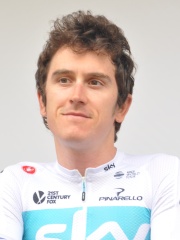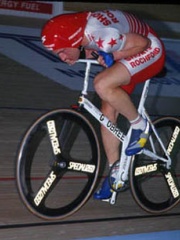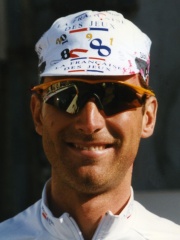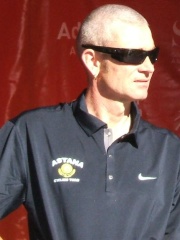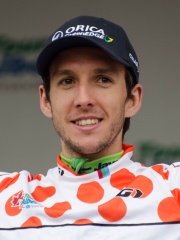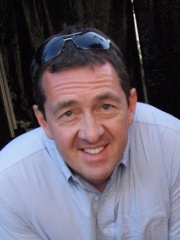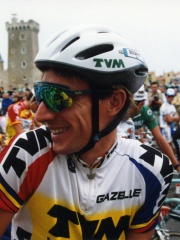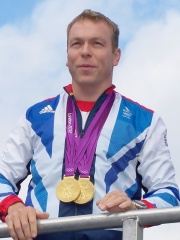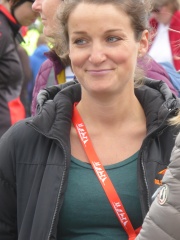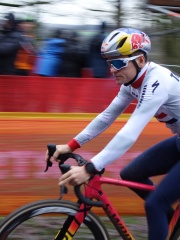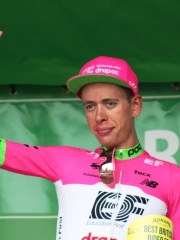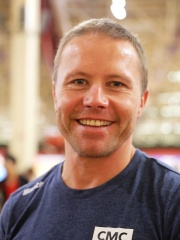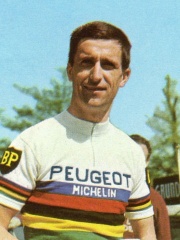
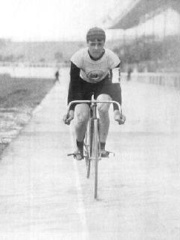
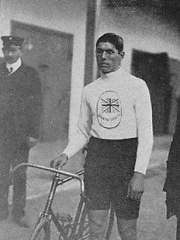
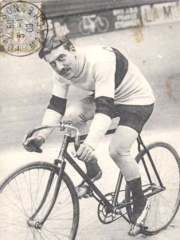
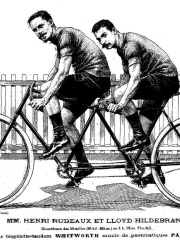
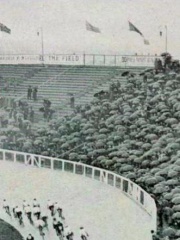
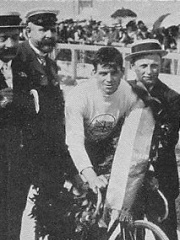
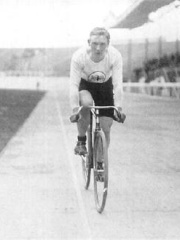
The Most Famous
CYCLISTS from United Kingdom
This page contains a list of the greatest British Cyclists. The pantheon dataset contains 1,214 Cyclists, 61 of which were born in United Kingdom. This makes United Kingdom the birth place of the 8th most number of Cyclists behind Netherlands and Australia.
Top 10
The following people are considered by Pantheon to be the top 10 most legendary British Cyclists of all time. This list of famous British Cyclists is sorted by HPI (Historical Popularity Index), a metric that aggregates information on a biography’s online popularity. Visit the rankings page to view the entire list of British Cyclists.

1. Tom Simpson (1937 - 1967)
With an HPI of 58.22, Tom Simpson is the most famous British Cyclist. His biography has been translated into 29 different languages on wikipedia.
Thomas Simpson (30 November 1937 – 13 July 1967) was one of Britain's most successful professional cyclists. He was born in Haswell, County Durham, and later moved to Harworth, Nottinghamshire. Simpson began road cycling as a teenager before taking up track cycling, specialising in pursuit races. He won a bronze medal for track cycling at the 1956 Summer Olympics and a silver at the 1958 British Empire and Commonwealth Games. In 1959, at age 21, Simpson was signed by the French professional road-racing team Saint-Raphaël–R. Geminiani–Dunlop. He advanced to their first team (Rapha–Gitane–Dunlop) the following year, and won the 1961 Tour of Flanders. Simpson then joined Gitane–Leroux–Dunlop–R. Geminiani; in the 1962 Tour de France he became the first British rider to wear the yellow jersey, finishing sixth overall. In 1963 Simpson moved to Peugeot–BP–Englebert, winning Bordeaux–Paris that year and the 1964 Milan–San Remo. In 1965 he became Britain's first professional world road race champion and won the Giro di Lombardia; this made him the BBC Sports Personality of the Year, the first cyclist to win the award. Injuries hampered much of Simpson's 1966 season. He won two stages of the 1967 Vuelta a España before he won the general classification of Paris–Nice that year. In the thirteenth stage of the 1967 Tour de France, Simpson collapsed and died during the ascent of Mont Ventoux. He was 29 years old. The post-mortem examination found that he had mixed amphetamines and alcohol; this diuretic combination proved fatal when combined with the heat, the hard climb of the Ventoux and a stomach complaint. A memorial near where he died has become a place of pilgrimage for many cyclists. Simpson was known to have taken performance-enhancing drugs during his career, when no doping controls existed. He is held in high esteem by many fans for his character and will to win.

2. Benjamin Jones (1882 - 1963)
With an HPI of 48.31, Benjamin Jones is the 2nd most famous British Cyclist. His biography has been translated into 20 different languages.
Benjamin Jones (2 January 1882 – 20 August 1963) was a British track cycling racer who competed in the 1908 Summer Olympics. In 1907, he won the one and five mile events at the British Empire cycling championships at Newcastle. Soon after, his professional cyclist license was revoked after an altercation with another cyclist. His attendance at the 1908 Olympics was thus in question until he was finally reinstated just before the event. In 1908 he won the gold medal in the 5000 metres competition as well as in the team pursuit as member of the British team. He also won a silver medal in the 20 kilometres event. He competed in the 660 yards competition but was eliminated in the semi-finals. In the sprint event he participated in the final and came second, but the pre-arranged time limit was exceeded, resulting in the race being declared void and no medals being awarded.

3. Leonard Meredith (1882 - 1930)
With an HPI of 45.89, Leonard Meredith is the 3rd most famous British Cyclist. His biography has been translated into 18 different languages.
Leonard "Leon" Lewis Meredith (2 February 1882 – 27 January 1930) was a British track and road racing cyclist who competed in the 1908 Summer Olympics, in the 1912 Summer Olympics, and in the 1920 Summer Olympics. He won seven world championships and set up one of Britain's largest cycle-parts companies and ran a roller-skating rink and ballroom.

4. Georges Passerieu (1885 - 1928)
With an HPI of 45.74, Georges Passerieu is the 4th most famous British Cyclist. His biography has been translated into 15 different languages.
George Leon Passerieu (London, 18 November 1885–Épinay-sur-Orge, 5 May 1928) was a British-born French professional road bicycle racer, who won seven stages in the Tour de France, and reached the podium twice. He also was the winner of Paris–Roubaix and Paris–Tours.

5. Frederick Keeping (1867 - 1950)
With an HPI of 45.32, Frederick Keeping is the 5th most famous British Cyclist. His biography has been translated into 24 different languages.
Frederick Keeping (11 August 1867 – 21 February 1950) was a British racing cyclist. He competed at the 1896 Summer Olympics in Athens. Keeping competed in the 333 metres and 12 hours races. In the 12 hours race, Keeping was one of only two cyclists to finish, covering 314.664 kilometres. He was only one lap behind the winner, Adolf Schmal, who covered 314.997 kilometres. Keeping tied with two others for fifth place in the 333m, with 27.0 seconds.

6. Lloyd Hildebrand (1870 - 1924)
With an HPI of 44.94, Lloyd Hildebrand is the 6th most famous British Cyclist. His biography has been translated into 15 different languages.
Lloyd Augustin Biden Hildebrand (25 December 1870, in Tottenham, United Kingdom – 1 April 1924, in Levallois-Perret, France) was a British racing cyclist who competed in the late 19th century and early 20th century. Hildebrand was still a British citizen in 1900, although he lived in France for much of his life and married a Frenchwoman. He participated in cycling at the 1900 Summer Olympics in Paris, winning the silver medal in the men's 25 kilometre race. Bronze medal 1900 Track Cycling World Championships.

7. Charles Henry Bartlett (1885 - 1968)
With an HPI of 44.38, Charles Henry Bartlett is the 7th most famous British Cyclist. His biography has been translated into 15 different languages.
Charles Henry Bartlett (6 February 1885, in Bermondsey, London – 30 November 1968, in Enfield) was a British track cyclist. He competed in the 1908 Summer Olympics where he won the gold medal in the 100 kilometres competition, completing the course in a time of 2 hours 41 minutes and 48.6 seconds.

8. Victor Johnson (1883 - 1951)
With an HPI of 43.40, Victor Johnson is the 8th most famous British Cyclist. His biography has been translated into 17 different languages.
Victor Louis Johnson, Vic Johnson, (10 May 1883 – 23 June 1951) was a British track cycling racer who, in 1908, won a gold medal at the 1908 Summer Olympics; became 'World Amateur Sprint Champion' and the 'British National Quarter-mile Champion'. In September 1909 he set three world records at Herne Hill Velodrome, London, for quarter-mile, three-quarter mile and one mile. His quarter-mile time (28 seconds) stood as the world record for 21 years and as the British amateur record for 'at least 39 years'. His lifetime achievements were celebrated in 1948 when Cycling Weekly awarded him his own page in the Golden Book of Cycling, which is now held in 'The Pedal Club' archive.

9. Clarence Kingsbury (1882 - 1949)
With an HPI of 42.70, Clarence Kingsbury is the 9th most famous British Cyclist. His biography has been translated into 18 different languages.
Clarence Brickwood Kingsbury (3 November 1882 – 4 March 1949) was a British track cyclist who competed in the 1908 Summer Olympics. He belonged to the Paddington and North End cycling clubs.
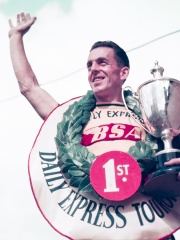
10. Gordon Thomas (1921 - 2013)
With an HPI of 42.45, Gordon Thomas is the 10th most famous British Cyclist. His biography has been translated into 16 different languages.
Gordon W. "Tiny" Thomas (18 August 1921 – 10 April 2013) was a British cyclist who competed at the 1948 Summer Olympics in London. There he won a silver medal in the team road race alongside Bob Maitland and Ian Scott. He also competed in the individual event, finishing 8th in a field of 101 participants. Born in Shipley, West Riding of Yorkshire, he served during World War II with the Royal Artillery in Africa and Italy. After his Olympic experience, he went on to win the 1953 Tour of Britain before retiring from cycling to enter the wool business.
Pantheon has 61 people classified as cyclists born between 1867 and 1999. Of these 61, 50 (81.97%) of them are still alive today. The most famous living cyclists include Phil Anderson, Geraint Thomas, and Graeme Obree. The most famous deceased cyclists include Tom Simpson, Benjamin Jones, and Leonard Meredith. As of April 2022, 10 new cyclists have been added to Pantheon including Georges Passerieu, Lloyd Hildebrand, and Sean Yates.
Living Cyclists
Go to all Rankings
Phil Anderson
1958 - Present
HPI: 40.99
Geraint Thomas
1986 - Present
HPI: 38.20
Graeme Obree
1965 - Present
HPI: 37.48
Max Sciandri
1967 - Present
HPI: 37.25
Sean Yates
1960 - Present
HPI: 37.08
Simon Yates
1992 - Present
HPI: 36.50
Dan Martin
1986 - Present
HPI: 35.57
Chris Boardman
1968 - Present
HPI: 35.25
Adam Yates
1992 - Present
HPI: 34.32
Philippa York
1958 - Present
HPI: 32.96
Chris Hoy
1976 - Present
HPI: 32.72
Lizzie Deignan
1988 - Present
HPI: 31.95

Deceased Cyclists
Go to all Rankings
Tom Simpson
1937 - 1967
HPI: 58.22
Benjamin Jones
1882 - 1963
HPI: 48.31
Leonard Meredith
1882 - 1930
HPI: 45.89
Georges Passerieu
1885 - 1928
HPI: 45.74
Frederick Keeping
1867 - 1950
HPI: 45.32
Lloyd Hildebrand
1870 - 1924
HPI: 44.94
Charles Henry Bartlett
1885 - 1968
HPI: 44.38
Victor Johnson
1883 - 1951
HPI: 43.40
Clarence Kingsbury
1882 - 1949
HPI: 42.70
Gordon Thomas
1921 - 2013
HPI: 42.45
Ronald Stretton
1930 - 2012
HPI: 41.22

Newly Added Cyclists (2022)
Go to all Rankings
Georges Passerieu
1885 - 1928
HPI: 45.74
Lloyd Hildebrand
1870 - 1924
HPI: 44.94
Sean Yates
1960 - Present
HPI: 37.08
Tom Pidcock
1999 - Present
HPI: 31.01
Tao Geoghegan Hart
1995 - Present
HPI: 29.10
Hugh Carthy
1994 - Present
HPI: 26.25
Yvonne McGregor
1961 - Present
HPI: 25.66
Ethan Hayter
1998 - Present
HPI: 23.86
Jack Carlin
1997 - Present
HPI: 23.69
Craig MacLean
1971 - Present
HPI: 21.41

Which Cyclists were alive at the same time? This visualization shows the lifespans of the 11 most globally memorable Cyclists since 1700.


